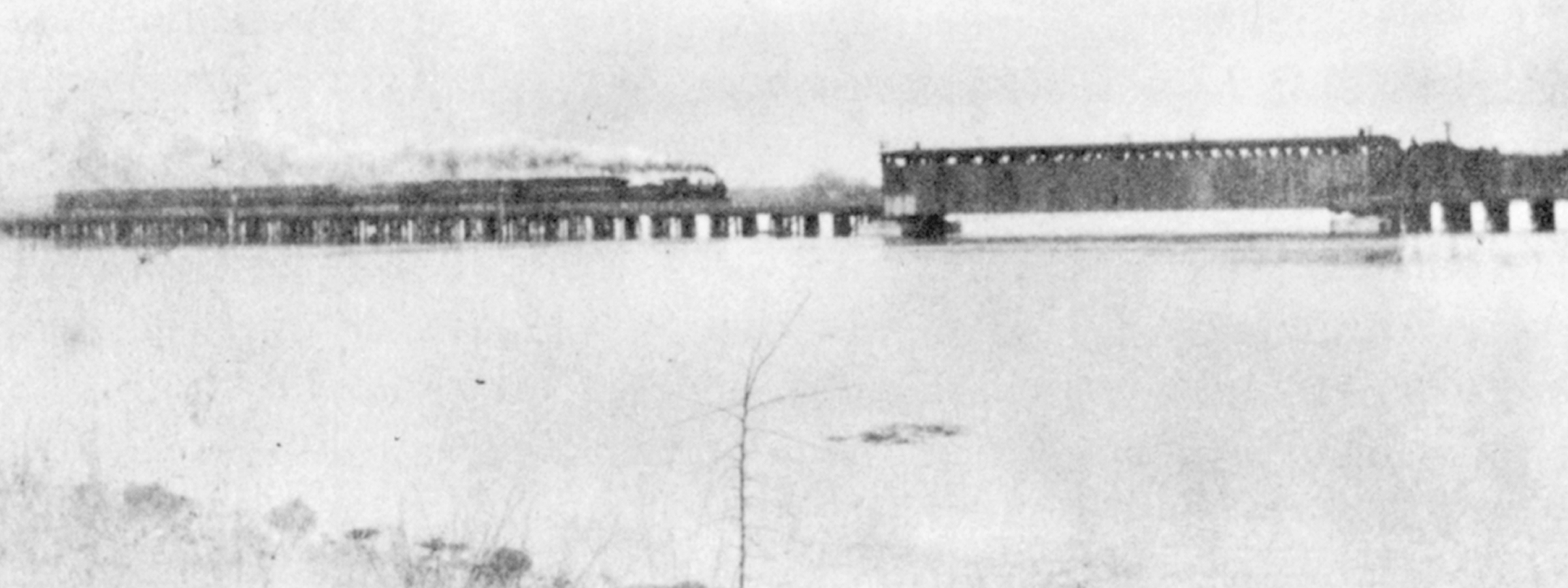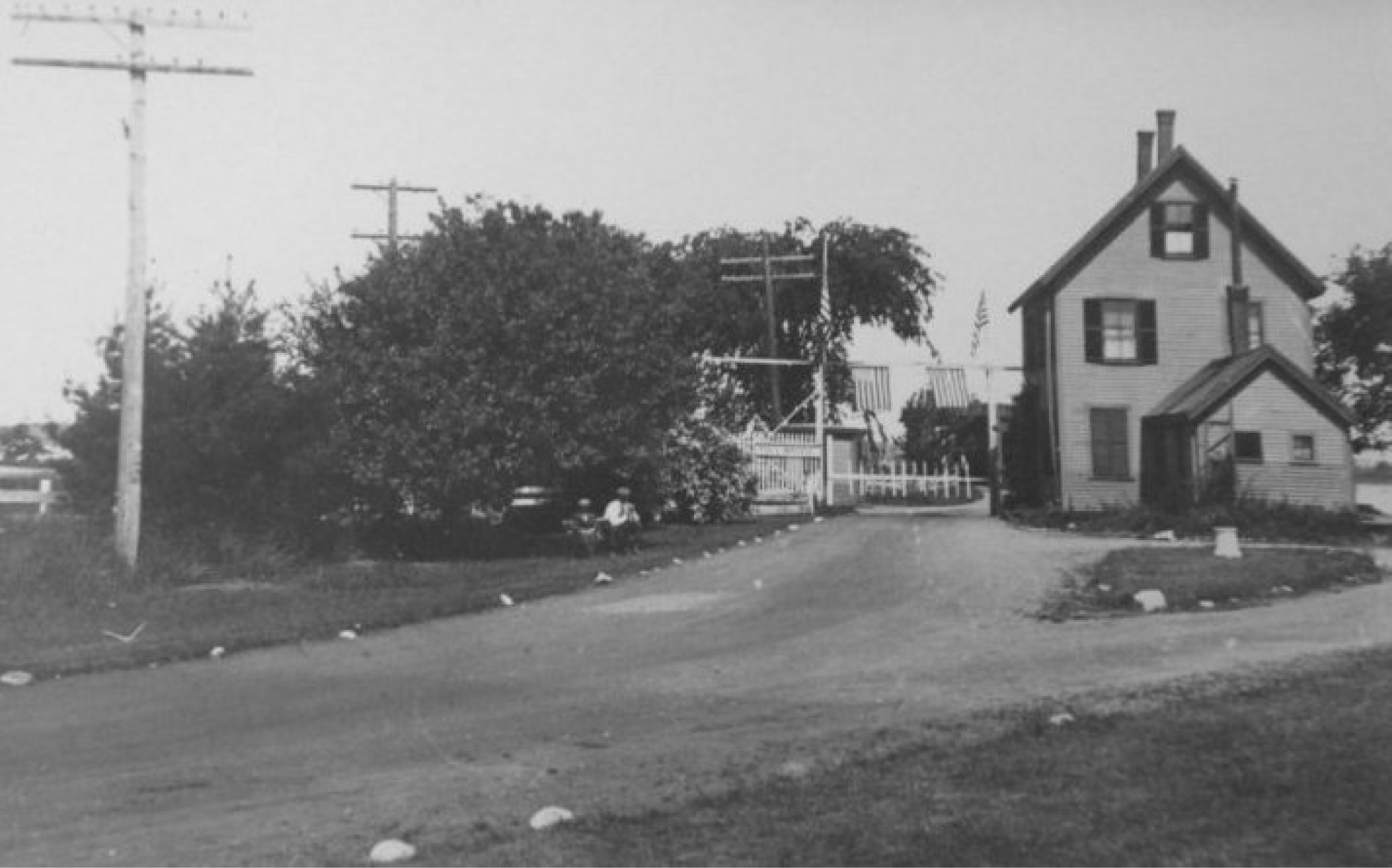Newington Railroad Depot
The Portsmouth & Dover Railroad was built in 1873 by Frank Jones in order to facilitate the transport of grain to his Portsmouth brewery.
The Newington Railroad Depot was built over the narrowest point over the Piscataqua River as part of the Portsmouth and Dover Railroad. The Portsmouth and Dover Railroad Company was chartered in 1866 in order to provide a link between the eastern and western divisions of the Boston and Maine Railroad and also included the means to cross the River. The rail line was completed in 1874 and included this railroad depot which included a residence for the stationmaster who collected tolls from pedestrians and carriages crossing the bridge nearby, and operated the swing section of the bridge to permit boat traffic to pass.
By 1915, a one story wing was constructed which served as a 10’x20′ waiting room and ticket office. The offshoot rail line remained in service until the completion of the General Sullivan Bridge in 1934. Due to the popularity of the automobile, the rail line was subsequently abandoned, and the nearby tracks were taken up in 1940. Elmer Brooks, the longtime stationkeeper was allowed to remain in the old depot, renting the building from the State of New Hampshire, who acquired the site in 1940. He lived here until his death in 1971.
Boston & Maine locomotives frequently bore names and this old wood burner was named "Newington." Photo courtesy of the Portsmouth Athenaeum. Photo courtesy of the Portsmouth Athenaeum.
The Newington Railroad
In order to deliver supplies to his Portsmouth breweries, Frank Jones and his partners were involved in several railroads including the Boston & Maine and the Portsmouth & Dover Railroads.
Ground breaking for the P&D RR occurred November 25, 1872 in Dover. The railroad had been a dream for over 20 years after the 1794 Piscataqua Bridge from Fox Point in Newington to Durham had been taken out by ice floes in the early 1850s. The first engine came over the road December 21, 1873.
Piscataqua River toll bridge.
Toll Bridge
The original Dover Point Bridge was built in 1873. On March 14, 1918 one half of the bridge was swept away by a large sheet of ice from Great Bay.
The Dover Point Bridge spanned the river from Hilton Point in Dover to Bloody Point in Newington.
The truss of this railroad bridge was put into position on December 11, 1873 using two schooners to float it and two tugs for power. It was 200 feet long, 40 feet wide and 25 feet high. The first engine came over the road December 21, 1873. The road was formally opened to public travel February 9, 1874. Miss Emma Bean of Newington was the first to cross it. After a portion of the bridge was taken out by ice, it was later replaced by the General Sullivan bridge in 1934.
Location Timeline
Bloody Point is one of the oldest locations in this country. The Point was settled in 1630 as part of Dover.
Its location beside the Piscataqua River and across from Maine has a long and varied history as a transportation corridor, first involving ferries and schooners, later railroads and carriages, and most recently automobiles. The location is steeped in maritime and railroad history and undoubtedly contributed to the economic development of inland portions of the region as transportation technology improved through the centuries.
- 1630
- Bloody Point settled, later became a district of Dover.
- 1640
- Earliest ferries operated between Bloody Point and Dover.
- 1660
- Dover Point Road traveled to the river crossing to Dover at an early date. The approximate route of what is now Nimble Hill Road connected the center of Newington to Bloody Point by 1660.
- 1681
- Road was built between Portsmouth and the Bloody Point ferry crossing.
- 1873
- Depot/toll house was built during construction of the Portsmouth and Dover Railroad
- 1874-1884
- Eastern Railroad operated
- 1884
- Boston and Maine Eastern Division operated
- 1900-1910s
- Station agents/bridge tenders/toll collectors were living in the depot/toll house for at least two decades at the turn of the century.
- 1918
- Spring ice damaged the railroad/vehicular bridge, repairs were completed in 3 months.
- 1934
- General Sullivan Bridge was built. Boston and Maine Railroad was given permission to abandon the Portsmouth and Dover line.
- 1937
-
NH legislation – "The Governor and Council are hereby authorized and empowered to acquire for the state, either by purchase or by eminent domain, real estate adjacent to the approaches of the General John Sullivan Memorial and the Alexander Scammell bridges necessary or suitable for park and recreational areas, as shown on plans filed in the office of the secretary of state entitled (1) Plan showing park area at the approaches..."
State of NH acquired the land with the depot/toll house with the intention of creating parks on both ends of the General Sullivan Bridge; the railroad tracks were removed in 1940. Hilton Park was developed on the Dover side but nothing in Newington.
- 1930s-1971
- Elmer Brooks rented the depot/tollhouse from the state
- 1972
- 20-year lease agreement (Bk 2127 Page 252) to the depot/toll house between the Town of Newington and the State of New Hampshire, Department of Public Works and Highways, approved by the Governor and Council on February 29, 1972 and formalized on March 1, 1972.
- 1973
- $2000 in budget for Bloody Point Project, $1026 expended in 1974
- 1974
-
Town meeting established the Newington Historical District Commission (HDC).
December - HDC agreed that the area around the depot should be “designated an historic area. Reasons for doing so include: the marker for the ferry, evidence of the cattle run, the railroad station, and the natural features of the site. … The area should not be developed as a picnic park, but rather be opened to the public for historical and geographical reasons. A nature and historic trail could easily be developed with points of interest suitably marked.”
The HDC voted that money should be put in the 1975 budget to improve at least the outside of the railroad depot.
- 1975
-
January - R.W. Whitaker, Commissioner agreed to designating the state-owned land northeasterly of the General Sullivan Bridge as a Newington Historic District.
March - Town Meeting designated Bloody Point with the Railroad Depot as Newington’s second historic district. The selectmen gave the HDC the responsibility of restoring it and developing plans for its use.
Bloody Point Park Project Plans
The State of New Hampshire currently owns the Bloody Point Depot property. However, it is part of a Section 106 process that requires the preservation and rehabilitation of the railroad depot when the historic General Sullivan Bridge is dismantled and replaced. The November 2021 Memorandum of Agreement intends to transfer the depot property to Newington.
Read more about the project plans
















